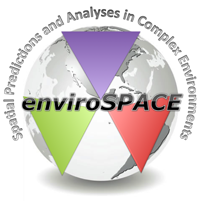 The enviroSPACE laboratory is dedicated to spatial analyses within the Institute for Environmental Sciences at the University of Geneva, as part of the Dpt. F.-A. Forel for environmental and aquatic sciences.
The enviroSPACE laboratory is dedicated to spatial analyses within the Institute for Environmental Sciences at the University of Geneva, as part of the Dpt. F.-A. Forel for environmental and aquatic sciences.
We currently coordinate the H2020 GEOEssential project on building workflows based on Essential Variables form Earth Observations to Policy indicators. We are participating to the ValPar.CH project on the added value of Ecological Infrastructure in Swiss regional parks. We contribute to the development of the Swiss Data Cube..
We coordinated the SNF projects: SWATCH21 on eco-hydrological services in Swiss rivers under climate change.
We coordinated the FP7 enviroGRIDS and EOPOWER projects, and participated to the FP7 IASON, ACQWA, PEGASO, AfroMaison and EcoArm2ERA projects, as well as the SNF SCOPES ARPEGEO project, and the CRUS/SCIEX enviroPAD project.
We work closely with the UNEP/GRID-Geneva team on several projects since 15 years.
We collaborate closely with the GE21 group on biodiversity and ecosystem services and the GE-EN-VIE network as a science-policy interface in Geneva. We participate also to the activities of SITG, the Geneva collaborative GIS platform.
We also contribute to the Digital Solutions for Environment and Health hub at ISE. Our expertise is being taught at the University of Geneva by our active contributions to the cursus of the Master of Environmental Sciences, the Certificate of Geomatics
- Our aim is to promote interdisciplinary research based on spatially explicit information and indicators on the past, present and future state of changing and complex environment. We are building several Spatial Data Infrastructures (SDI) to improve data sharing and processing.
- Our challenge is clearly to fill the gap between scientific information on one hand and decision making on the other hand, in order to improve the sustainable management of our unique and fragile environment.
- Our toolbox is composed of traditional GIS, remote sensing, relational data bases and statistical analyses, as well as dedicated modeling tools in Ecology, Hydrology, Demography, Climate, Global Health, Risks or Land Cover analyses.
These geoprocessing tools are producing spatially explicit outputs at various scales. Methods for downscaling and upscaling geographic information are used to integrate them in order to asses for instance the vulnerability, sustainability or services of ecosystems.
These geoprocessing tools are also requesting more and more computing power to manage complex workflows on large datasets. We are therefore exploring ways to run these geoprocesses on the Internet and on distributed computing solutions (clusters, grids and clouds).
